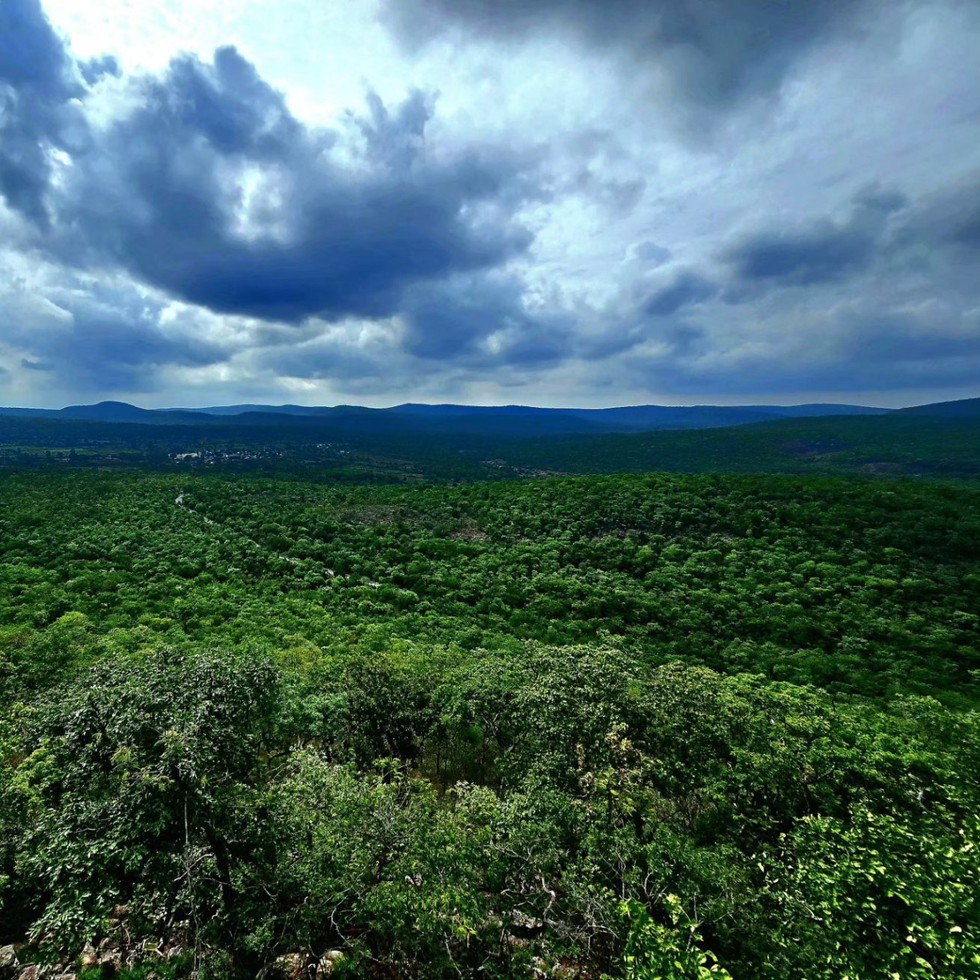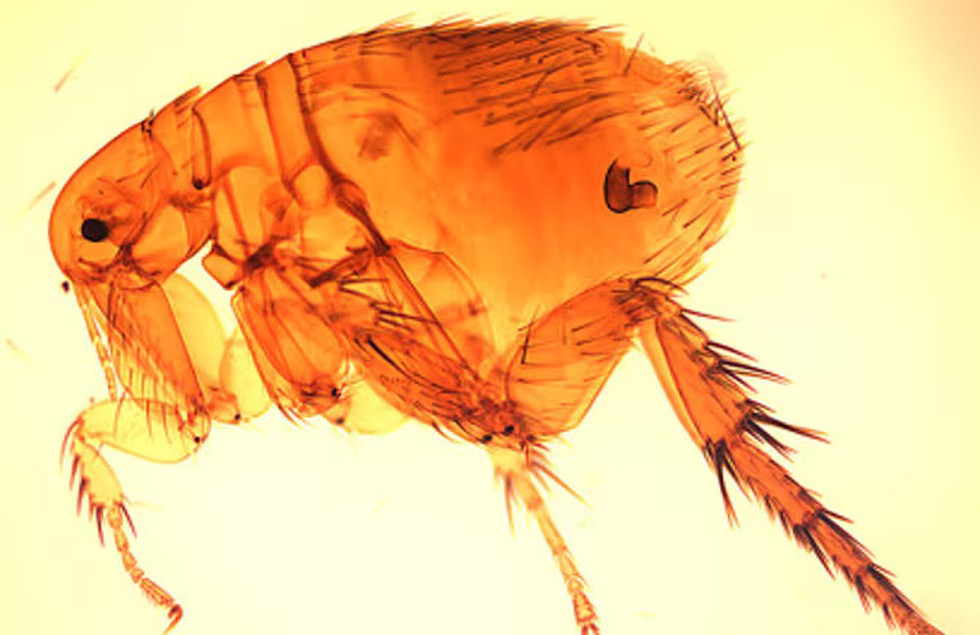
About Nagarjunsagar-Srisailam Tiger Reserve (NSTR):
- Location: It is located in the Nallamala hill ranges(an offshoot of the Eastern Ghats) of Andhra Pradesh.
- This is the largest tiger reserve in the country, spreading over an area of 5937 sq. km.
- It hosts the largest tiger population in the Eastern Ghat
- It is named after two major damsin the area, Nagarjuna Sagar Dam and Srisailam Dam.
- Two wildlife sanctuaries, namely Rajiv Gandhi Wildlife Sanctuaryand Gundla Brahmeswaram Wildlife Sanctuary (GBM), constitute the NSTR.
- The river Krishna traverses through this reserve for a linear distance of around 270 kilometers.
- Topography: It consists of plateau, ridges, gorges, and deep valleys.
- Vegetation: Tropical dry deciduous forestshave an undergrowth of bamboo and grass.
- Flora: The habitat has several endemics like Andrographis nallamalayana, Eriolaena lushingtonii, Crotalaria madurensis Var, Dicliptera beddomei, and Premna hamiltonii.
- Fauna:
- Top faunal species include Tiger, Leopard, Wolf, Wild Dog and Jackal.
- The prey species are represented by Sambar, Chital, Chowsingha, Chinkara, Mouse Deer, Wild boar, and Porcupine.
- The river Krishna has Muggers, Otters and Turtles.
2. Kalleshwar Temple

About Kalleshwar Temple:
- It is a Hindu temple located in the town of Bagali in the Davangere district of Karnataka.
- It is one of the oldest temples in the region and is dedicated to Lord Shiva.
- The construction of the temple spans the rule of two Kannada dynasties: the Rashtrakuta Dynasty during the mid-10th century, and the Western Chalukya Empire, during the reign of founding King Tailapa II around 987 AD.
- Architecture:
- The temple is a single shrine construction with an adjoining hall (mantapa).
- The temple, which faces east, comprises a sanctum, an antechamber (or vestibule or antarala, whose tower is called the sukhanasi), that connects the sanctum to a gathering hall (sabhamantapa), which is preceded by a main hall (mukhamantapa).
- The Shikara of the temple is a perfect example of early Cholan architecture.
- The temple houses a large Shivalinga, which is believed to be more than a thousand years old.
- This temple is protected as a monument of national importance by the Archaeological Survey of India.
3. Key Facts about Earthworms

About Earthworms:
- They are terrestrial worms of the class Oligochaeta (phylum Annelida)—in particular, members of the genus Lumbricus.
- Earthworms are harmless, often beneficial residents of the soil.
- Earthworms occur in virtually all soils of the world in which the moisture and organic content are sufficient to sustain them.
- Features:
- The earthworm body is divided into ringlike segments. Some internal organs, including the excretory organs, are duplicated in each segment.
- They don’t have lungs; they breathe through their skin.
- They also lack eyes, so instead use receptors in their skin to sense light and touch.
- Earthworms have five “hearts” that pump blood through their bodies.
- Their food consists of decaying plants and other organisms; as they eat, however, earthworms also ingest large amounts of soil, sand, and tiny pebbles.
- Earthworms are hermaphrodites, meaning an individual worm has both male and female reproductive organs.
- Benefits:
- Earthworms break down dead and decaying organic matter into rich humus soil, thereby supporting plant growth.
- Earthworms release waste from their bodies called castings. Castings contain many nutrients that the plant can use.
- They also dig tiny channels and make holes that aerate the soil and improve drainage.
4. What are Alkanes?

About Alkanes:
- Alkanes are organic compounds that consist entirely of single-bonded carbon and hydrogen atoms and lack any other functional groups.
- Alkanes have the general formula CnH2n + 2 (where n is an integer).
- Alkanes can be subdivided into three groups: linear straight-chain alkanes,branched alkanes, and cycloalkanes.
- They show little chemical affinity for other substances and are chemically inert to most laboratory reagents.
- They are also relatively inert biologically and are not often involved in the chemistry of living organisms.
- Alkanes do, however, react with oxygen, halogens, and a few other substances under appropriate conditions.
- Reaction with oxygen occurs during combustion in an engine or furnace when an alkane is used as a fuel.
- Carbon dioxide and water are formed as products, and a large amount of heat is released.
- They are commercially very important, being the principal constituent of gasoline and lubricating oils and are extensively employed in organic chemistry.
- Examples of alkane include methane, ethane, propane, butane, etc.
5. What is Serious Fraud Investigation Office (SFIO)?

About Serious Fraud Investigation Office (SFIO):
- It is a corporate fraud investigating agency set up by the Government of India.
- The SFIO was established on 21st July, 2015. Section 211 of the Companies Act, 2013, accorded a statutory status to the SFIO.
- SFIO is a multi-disciplinary organization under the Ministry of Corporate Affairs, consisting of experts in the fields of accountancy, forensic auditing, law, information technology, investigation, company law, capital markets and taxation for detecting and prosecuting or recommending for the prosecution of white-collar crimes/frauds.
- SFIO takes up for investigation cases characterized by:
- Complexity and having interdepartmental and multidisciplinary ramifications.
- Substantial involvement of public interest to be judged by size, either in terms of monetary.
- The possibility of investigation leading to or contributing towards a clear improvement in systems, laws, or procedures.
- Investigate serious cases of fraud received from the Department of Company Affairs.
- Investigation into the affairs of a company is assigned to SFIO, where the Government is of the opinion that it is necessary to investigate into the affairs of a company-
- on receipt of a report of the Registrar or inspector under section 208 of the Companies Act, 2013
- on intimation of a special resolution passed by a company that its affairs are required to be investigated
- In the public interest; or on request from any department of the Central Government or a State Government
- The SFIO can also take up cases on its own only when decided by the Director of the SFIO, and also giving the reasons for taking up the case in writing.
- Upon assignment of a case to the SFIO, no other investigative agency can proceed with an investigation for any offence under the Act.
- SFIO is headed by a Director as Head of Department in the rank of Joint Secretary to the Government of India.
- The Director is assisted by Additional Directors, Joint Directors, Deputy Directors, Senior Assistant Directors, Assistant Directors, Prosecutors, and other secretarial staff.
- The headquarters of SFIO is in New Delhi with its regional offices in Mumbai, Chennai, Hyderabad, and Kolkata.
6. What are Dragon drones?

About Dragon Drones:
- Dragon drones essentially release a substance called thermite — a mixture of aluminium and iron oxide — developed a century ago to weld railroad tracks.
- Working
- When ignited (usually with the help of an electrical fuse), thermite triggers a self-sustaining reaction that is quite difficult to extinguish.
- It can burn through almost anything, from clothes to trees to military-grade vehicles, and can even burn underwater.
- On humans, it causes severe, possibly fatal, burns and bone damage.
- Combining thermite with high-precision drones that can bypass traditional defences makes dragon drones ‘highly effective’ and ‘dangerous’
- In recent times these dragon drones are believed to have been first deployed in the Russia-Ukraine war around September.
- International regulation
- The use of thermite in war is not prohibited under international law.
- However, the use of such incendiary weapons against civilian targets is barred under the Convention on Certain Conventional Weapons — Cold War-era guidance issued under the auspices of the United Nations.
7. New Spider Species

About New Spider Species:
- A new species of spider named Tenkana Jayamangali, has been found at Devarayanadurga reserve forest of Karnataka.
- It was named after the nearby Jayamangali River.
- It is a sister species to T arkavathi and T manu.
- It has been added as a new genus of Tenkana jumping spiders (Salticidae, Plexippina) from South Asia.
- Key points about Tenkana genus
- Distribution: The southern states of India (Andhra Pradesh, Karnataka, Kerala, Tamil Nadu and Telangana) and the northern region of Sri Lanka.
- Tenkana appears to be an exclusively ground-dwelling group.
- It is often found among relatively complex microhabitats of shaded short grasses with dry leaf litter in groves or relatively simpler microhabitats in open, sunny, sparse short grasses associated with rocky outcrops in relatively dry habitats.
8. What is X-band radar?

About X-band radar:
- An X-band radar is a radar that emits radiation in the X-band of the electromagnetic spectrum: 8-12 GHz, corresponding to wavelengths of around 2-4 cm.
- The smaller wavelengths allow the radar to produce images of higher resolution.
- However, the greater the frequency of some radiation, the faster it will be attenuated.
- Applications
- The new radar is expected to be able to monitor the movements of particles, such as soil, to inform landslide warnings.
- The device will also perform high temporal sampling, that is, rapidly sample its environs, allowing it to spot particle movements happening in shorter spans of time.
- These radars are typically used for studies about cloud development and light precipitation due to their ability to detect tiny water particles and snow.
What is Radar?
- Radar is short for ‘radio detection and ranging’.
- The device uses radio waves to determine the distance, velocity and physical characteristics of objects around the device.
- A transmitter emits a signal aimed at an object whose characteristics are to be ascertained (in meteorology, this could be a cloud). A part of the emitted signal is echoed by the object back to the device, where a receiver tracks and analyses it.
- Weather radar, also known as Doppler radar, is a common application of this device. The Doppler effect is the change in the frequency of sound waves as their source moves towards and away from a listener.
- In meteorology, Doppler radars can reveal how fast a cloud is moving and in which direction based on how the cloud’s relative motion changes the frequency of the radiation striking it.
- A pulse-Doppler radar can measure the intensity of, say, rainfall by emitting radiation in pulses and tracking how often they’re reflected to the receiver.
- This way, modern Doppler radars can monitor weather conditions and anticipate new wind patterns, the formation of storms, etc.
9. Rare Diseases

About Rare Diseases:
- A rare disease is a health condition of low prevalence that affects a small number of people compared with other prevalent diseases in the general population.
- There are 7,000-8,000 classified rare diseases, but less than 5% have therapies available to treat them.
- A condition is considered to be a rare disease if its prevalence is less than one case per 1,000 population.
Categories of rare diseases
- In India, rare diseases are categorised into three groups based on the nature and complexity of available treatment options.
- Group 1 includes diseases that can be treated with a one-time curative procedure.
- Group 2 diseases require long-term or lifelong treatment which are relatively less costly and have shown documented benefits, but patients need regular check-ups.
- Group 3 diseases are those for which effective treatments are available, but they are expensive and must often continue lifelong. There are challenges in selecting the right beneficiaries for these treatments.
Financial assistance for rare diseases in India
- In 2021, the National Policy for Rare Diseases (NPRD) was launched, under which financial assistance up to Rs 50 lakh is provided to patients receiving treatment at identified Centres of Excellence (CoE).
- The CoEs include AIIMS in Delhi, PGIMER in Chandigarh and the Institute of Postgraduate Medical Education and Research at Kolkata’s SSKM Hospital.
- The Union Health Ministry opened a Digital Portal for Crowdfunding & Voluntary Donations with information about patients and their rare diseases, the estimated cost of treatment and bank details of the CoEs.
- Donors can choose the CoE and patient treatments they wish to support. Each CoE also has its own Rare Disease Fund, which is used with approval from its governing authority.
10. Murine Typhus

About Murine Typhus:
- It is an infectious disease caused by the flea-borne bacteria Rickettsia typhi.
- Transmission:
- It is transmitted to humans through the bites of infected fleas.
- It is also known as endemic typhus, flea-borne typhus or flea-borne spotted fever.
- Rodents like rats, mice and mongoose, are known to be reservoirs of the disease.
- The disease-carrying fleas can also live on other small mammals, including pets such as cats and dogs. Once a flea is infected, it can spread the disease for the rest of its life.
- Transmission can also happen through exposure of mucous membranes to infected flea faeces.
- It is spread when infected flea faeces come into contact with cuts or scrapes in the skin.
- Murine typhus is not spread from one person to another, or from person to fleas.
- The disease has been reported in coastal tropical and subtropical regions, where rats are prevalent.
- In India, cases of murine typhus have been reported in the Northeast, Madhya Pradesh and Kashmir.
- Symptoms
- The symptoms usually appear seven to 14 days after the exposure and include fever, headaches, body aches, joint pains, nausea, vomiting, and stomach aches.
- Some people may later develop rashes on the skin, days after the initial symptoms.
- Treatment
- There is no vaccine currently available against the disease.
- The antibiotic doxycycline is considered effective in therapy, but early diagnosis is vital for treatment.


























































































































































.png)
.png)
.png)
.png)
.png)


.png)
.png)
.png)





.png)
.png)






.png)
.png)
.png)
.png)
.png)
.png)
.png)
.png)
.png)

.png)







.png)
.png)


.png)
.png)
.png)


.png)

.png)
.png)





.jpg)

.png)
.png)


.png)

.png)
.png)
.png)

.jpg)

.jpg)


.png)

.png)
.png)
.png)
.png)
.png)
.png)
.png)
.png)
.png)
.png)




.png)

.png)





.png)
.png)
.png)
.png)
.png)
.png)
.png)
.png)
.png)
.png)
.jpg)
.jpg)

.png)
.png)
.png)
.png)
.png)
.png)
.png)
.png)
.png)
.png)
.png)
.png)
.png)
.png)
.png)
.png)
.png)
.png)
.png)
.png)
.png)
.png)



.png)
.png)

.jpg)
.jpg)


.jpg)
.jpg)
.jpg)
.jpg)
.jpg)

.jpg)








.jpg)
.jpg)
.jpg)
.jpg)
.jpg)

















.jpg)
.jpg)







.jpg)


















.jpg)
.jpg)






























































































.jpg)
.jpg)


























.jpg)

.jpg)










.jpg)








.jpg)




.jpg)










.jpg)


















.jpg)












































.jpg)














.jpg)
.jpg)
.jpg)





.jpg)

.jpg)
.jpg)





































































.jpg)


































.jpg)
.jpg)
















































.jpg)












.jpg)


.jpg)




.jpg)
.jpg)
.jpg)

.jpg)
.jpg)
.jpg)
.jpg)

.jpg)
.jpg)
.jpg)

.jpg)
.jpg)
.jpg)
.jpg)
.jpg)
.jpg)
.jpg)
.jpg)

.jpg)


.jpg)
.jpg)
.jpg)
.jpg)
.jpg)
.jpg)
.jpg)
.jpg)
.jpg)
.jpg)











.jpg)
.jpg)





.jpg)
.jpg)
.jpg)
























.jpg)
























.jpg)









.jpg)
.jpg)







.jpg)
.jpg)









































.jpg)
.jpg)
.jpg)
.jpg)
.jpg)

.jpg)
.jpg)
.jpg)
.jpg)
.jpg)


.jpg)
.jpg)
.jpg)
.jpg)
.jpg)

.jpg)
.jpg)
.jpg)
.jpg)
.jpg)
.jpg)
.jpg)
.jpg)
.jpg)
.jpg)
.png)

.png)
.png)

.png)
.png)
.png)
.png)


.jpg)
.jpg)

.jpg)
.jpg)
.jpg)

.png)
.png)
.png)
.png)
.png)
.png)
.png)

.png)
.png)
.png)
.png)
.png)
.png)
.png)
.png)
.png)
.png)





































































-min.png)



.png)




.png)








































